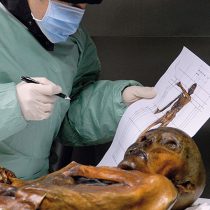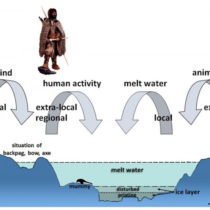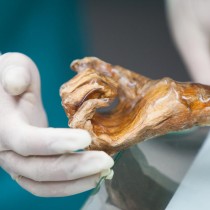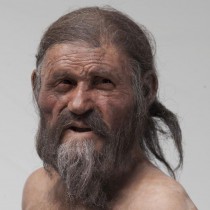The mummified body of Ötzi has serious injuries and bruises. Up to now no blood traces had been found on him. Now, after 21 years, scientists led by biological anthropologist Albert Zink, of the Ludwig Maximilian University in Munich and the Institute for Mummies and the Iceman in Bolzano, have located traces of blood on the wounds and were able to recover red cells.
The mummy has been the subject of constant study since 1991, when two German trekkers discovered it by chance in a glacier of the Italian Alps near the border between Italy and Austria, in South Tirolo, at an altitude of 3200 m.
Thanks to the ice, the body was very well preserved, allowing scientists to estimate his height (c. 1,6 m), his weight (25 pounds), the colour of his eyes and of his hair (brown), as well as his age (approximately 45 years old) at the moment of his violent death. Scientists believe Ötzi died by a flint arrow, which hit the Iceman in the back and cut an artery. In his stomach, remains of his last meal were found, which included red deer meat.
According to Zink, the fact that they found complete red blood cells, which do not differ from what our blood cells look like today, was surprising. The scientists took tissue samples from Ötzi’s arrow wound and from an earlier wound on the mummy’s hand. Using a light microscope, they identified the oldest red blood cells, which have been preserved for more than 5000 years.
To confirm the finding, the researchers used a technique called Raman spectroscopy, which uses light-scattering patterns to determine which molecules are present in a sample. The suspected blood cells had all the markers of true red blood cells, including hemoglobin, the protein that carries oxygen in the blood. While other researchers have attempted to identify blood on older stone tools, this is the oldest definite confirmation of blood, Zink said.
Traces of a protein called fibrin were also found in the blood from the arrow wound. Fibrin is a protein that appears immediately after a wound and helps the clotting process, but vanishes very quickly. This find, according to Zink, leads to the conclusion that Ötzi didn’t die immediately after he was hit, but did survive the arrow shot for some time.





